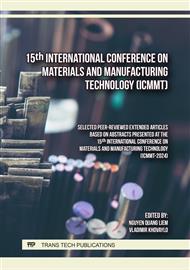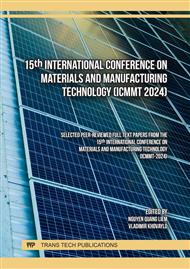[1]
J. R. Fanchi, Energy in the 21st Century, World Scientific Publishing Co. Pte. Ltd. (2005) 199-200.
Google Scholar
[2]
Asian Development Bank, Philippines: Energy Sector Assessment, Strategy, and Road Map, Country Sector and Thematic Assessments, (2018) 4,34.
DOI: 10.22617/tcs189616
Google Scholar
[3]
A. Z. AL Shaqsi, K. Sopian, and A. Al-Hinai, Review of energy storage services, applications, limitations, and benefits, Energy Reports. 6(7) (2020) 288-306.
DOI: 10.1016/j.egyr.2020.07.028
Google Scholar
[4]
L. Kumar, M. A.A. Mamun, and M. Hasanuzzaman, Energy Economics, in: MD. Hasanuzzaman, N.A. Rahim (Eds.), Energy for Sustainable Development: Demand, Supply, Conversion and Management, Elsevier Inc., 2019, pp.167-177.
DOI: 10.1016/b978-0-12-814645-3.00007-9
Google Scholar
[5]
P. Lilienthal, T. Lambert, and P. Gilman, Computer Modeling of Renewable Power Systems, in: CJ Cleveland (Ed.), Encyclopedia of Energy, Elsevier Inc., 2004, pp.633-647.
DOI: 10.1016/b0-12-176480-x/00522-2
Google Scholar
[6]
R.B. Rakhi, Preparation and properties of manipulated carbon nanotube composites and applications, in: A. Khan, M. Jawaid, Inamuddin, A. M. Asiri (Eds.), Nanocarbon and Its Composites: Preparation, Properties and Applications, Woodhead Publishing, United Kingdom, 2019, pp.489-520.
DOI: 10.1016/b978-0-08-102509-3.00016-x
Google Scholar
[7]
M. Vainoris, H. Cesiulis, and N. Tsyntsaru, Metal Foam Electrode as a Cathode for Copper Electrowinning, Coatings. 10(9) (2020) 822.
DOI: 10.3390/coatings10090822
Google Scholar
[8]
M.D.L. Balela, R.E. Masirag, F.O. Pacariem, and J.M.D. Taguinod, Electrochemical Fabrication of Porous Interconnected Copper Foam, Key Engineering Materials. 902 (2021) 9-14.
DOI: 10.4028/www.scientific.net/kem.902.9
Google Scholar
[9]
M.D.L. Balela, R.E. Masirag, F.O. Pacariem, and J.M.D. Taguinod, Effect of NaBr on the Pore Size and Surface Morphology of Cu Foam Prepared by Hydrogen Bubble Templating, Key Engineering Materials. 880 (2021) 83-88.
DOI: 10.4028/www.scientific.net/kem.880.83
Google Scholar
[10]
S.B. Orgen and M.D.L. Balela Effect of Reaction Time on the Morphology of CuO Nanostructured Electrode for Pseudocapacitor Application, Journal of Physics: Conference Series. 1974 (2021) 012006.
DOI: 10.1088/1742-6596/1974/1/012006
Google Scholar
[11]
M. Vainoris, N. Tsyntsaru, and H. Cesiulis, Modified Electrodeposited Cobalt Foam Coatings as Sensors for Detection of Free Chlorine in Water, Coatings. 9(5) (2019) 306.
DOI: 10.3390/coatings9050306
Google Scholar
[12]
W. Zhang, C. Ding, A. Wang, and Y. Zeng, 3-D Network Pore Structures in Copper Foams by Electrodeposition and Hydrogen Bubble Templating Mechanism, Journal of The Electrochemical Society. 162 (8) (2015) D365–D370.
DOI: 10.1149/2.0591508jes
Google Scholar
[13]
P. Arevalo-Cid, A. Adan-Mas, T. M. Silva, J. A. Rodrigues, E. Maçôas, M. F. Vaz and M. F. Montemora, On the growth and mechanical properties of nanostructured cobalt foams by dynamic hydrogen bubble template electrodeposition, Materials Characterization. 169 (2020) 110598.
DOI: 10.1016/j.matchar.2020.110598
Google Scholar
[14]
J. Niu, X. Liu, K. Xia, L. Xu, Y.Xu, X. Fang, and W. Lu, Effect of Electrodeposition Parameters on the Morphology of Three-Dimensional Porous Copper Foams, International Journal of Electrochemical Science. 10 (2015) 7331–7340.
DOI: 10.1016/s1452-3981(23)17352-4
Google Scholar
[15]
X. Fan, P. Ohlckers, & X. Chen, Tunable Synthesis of Hollow Co3O4 Nanoboxes and Their Application in Supercapacitors, Applied Sciences. 10(4) 2020 1208.
DOI: 10.3390/app10041208
Google Scholar
[16]
B. J. Plowman, L. A. Jones, and S. K. Bhargava, Building with Bubbles: The Formation of High Surface Area Honeycomb-like Films via Hydrogen Bubble Templated Electrodeposition, Chemical Communications. 51(21) (2015) 4331–4346.
DOI: 10.1039/c4cc06638c
Google Scholar
[17]
S. Vesztergom, A. Dutta, M. Rahaman, K. Kiran, I. Z. Montiel, and P. Broekmann, Hydrogen Bubble Templated Metal Foams as Efficient Catalysts of CO2 Electroreduction, ChemCatChem, 13 (2021) 1039–1058.
DOI: 10.1002/cctc.202001145
Google Scholar
[18]
P.S. Joshi, and D.S. Sutrave, A Brief Study of Cyclic Voltammetry and Electrochemical Analysis, International Journal of ChemTech Research. 11(9) (2018) 77–88.
DOI: 10.20902/ijctr.2018.110911
Google Scholar
[19]
Y. Ge, X. Xie, J. Roscher, R. Holze, and Q. Qu, How to Measure and Report the Capacity of Electrochemical Double Layers, Supercapacitors, and Their Electrode Materials, Journal of Solid State Electrochemistry. 24 (2020) 3215–3230. Authors' background Your Name
Title*
Research Field
Personal website
Christine Ann N. Macababbad
N/A (Recently graduated from the university)
N/A
N/A
Mary Donnabelle L. Balela
Professor
Sustainable Electronic Materials
N/A
DOI: 10.1007/s10008-020-04804-x
Google Scholar



